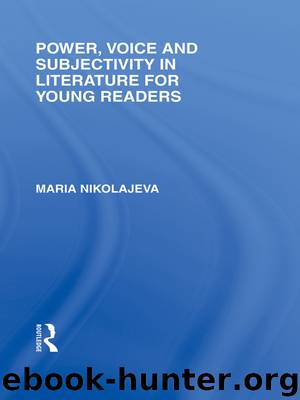Power, Voice and Subjectivity in Literature for Young Readers by Maria Nikolajeva

Author:Maria Nikolajeva
Language: eng
Format: epub
Publisher: Routledge
Published: 2011-01-01T16:00:00+00:00
Chapter Seven
Othering Gender: New Masculinities, New Femininities
From the previous chapter, it should be clear that there is a difference between masculine and feminine plots and between strategies of othering in young adult (YA) fiction, as compared to literature for younger readers, where genders are more interchangeable. Since male and female rites of passage, whether archaic or modern, follow different patterns, it should be anticipated that fictional representation of masculinity and femininity reflects the actual situation, yet at the same time is affected by other power hierarchies. Since masculinity is traditionally given priority in power relationships, it would seem natural that in YA novels male protagonists must confirm their masculinity, while female protagonists must negotiate their power position in compliance with patriarchal rules.
Although feminist approaches to children’s literature have been prominent for many years, we still lack a more precise metalanguage to discuss gender-related issues and too often get entangled in rigid definitions of female/male, feminine/masculine, which frequently depends on the scholar’s essentialist or constructivist approach respectively. The issues raised by feminist and queer criticism go far beyond the concept of gender, toward general questions of power and alterity. Further, the terminology provided by feminist and queer theories is limited since it is focused either on the binarity female/male (alternately feminine/masculine) or heterosexual/homosexual. Postcolonial theory provides yet another binarity: (ethnic) majority/minority, or imperialistic/ indigenous, yet another aspect of power hierarchy. Therefore I choose in discussions of gender speak of heterological rather than feminist or queer analysis. The culturally dependent term masculine, as opposed to the biological male should henceforth be understood as normative and empowered, while feminine equals disempowered, oppressed, deviant and silenced.
This statement is based on a number of preconceived opinions about masculine and feminine writing. I am using these exclusively as a point of departure for my discussion and do not in any way maintain that these prejudices are indeed true. Yet the premises come from previous gender-related studies of general and children’s texts, in which certain generalizations have been made, including gender stereotypes and gender-related textual features (Gilbert and Gubar 1977; Showalter 1989; Spender 1998; Stephens 1996 Trites 1997; Hourihan 1997; Wilkie-Stibbs 2002). I use the concepts of convention to refer to statements about what literary texts “normally” are and do. A convention implies that a majority of texts within a certain culture or timeframe follow a certain pattern. For instance, by convention, male authors use male protagonists while female authors use female protagonists. By convention, male protagonists appear in action-oriented genres while female protagonists appear in character-oriented stories. Some other preconceived opinions claim that masculine writing includes external focalization, open narrative space, goal-oriented plot, linear time, and logical, structured language, while feminine narration implies internal focalization, closed space, diffuse plot, circular time and fragmentary language.
It is trivial to point out that gender construction in fiction for teenage readers reflects societal changes and expectations. Boys and young men are exposed to societal pressures just as much as girls and young women, merely in a different manner. While girls,
Download
This site does not store any files on its server. We only index and link to content provided by other sites. Please contact the content providers to delete copyright contents if any and email us, we'll remove relevant links or contents immediately.
4 3 2 1: A Novel by Paul Auster(12281)
The handmaid's tale by Margaret Atwood(7678)
Giovanni's Room by James Baldwin(7189)
Asking the Right Questions: A Guide to Critical Thinking by M. Neil Browne & Stuart M. Keeley(5632)
Big Magic: Creative Living Beyond Fear by Elizabeth Gilbert(5610)
Ego Is the Enemy by Ryan Holiday(5294)
The Body: A Guide for Occupants by Bill Bryson(4974)
On Writing A Memoir of the Craft by Stephen King(4863)
Ken Follett - World without end by Ken Follett(4644)
Adulting by Kelly Williams Brown(4486)
Bluets by Maggie Nelson(4472)
Eat That Frog! by Brian Tracy(4433)
Guilty Pleasures by Laurell K Hamilton(4360)
The Poetry of Pablo Neruda by Pablo Neruda(4038)
Alive: The Story of the Andes Survivors by Piers Paul Read(3968)
White Noise - A Novel by Don DeLillo(3953)
Fingerprints of the Gods by Graham Hancock(3940)
The Book of Joy by Dalai Lama(3899)
The Bookshop by Penelope Fitzgerald(3775)
